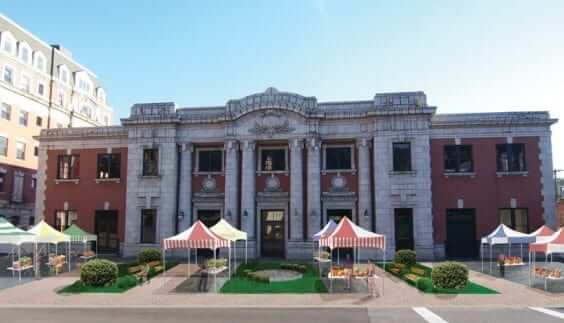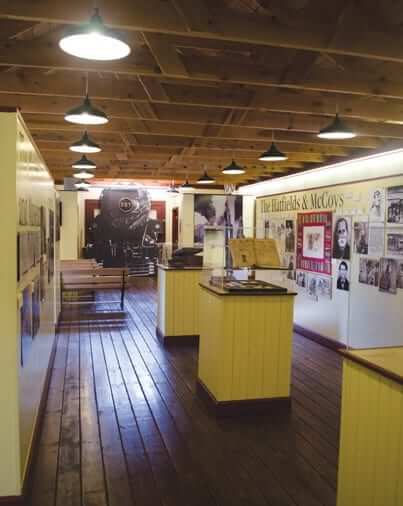Making change happen means breaking patterns, building bonds, and standing strong against resistance.

“Let me explain it to you,” says Dave Hatfield, of Matewan. “Have you ever been around someone who has lost everything they have and they’re at rock bottom and the only thing they have left is death, and then all of a sudden they grab onto something and they pull themselves out of it? Well, that’s what this is.” He’s talking, in part, about himself, and his turn to physical activity a few years ago to deal with his destructive, possibly deadly weight problem. “You get to the point where you have to do something, so I did something,” he says. He started running, and he didn’t stop—today Hatfield is in great shape, runs often, and is in charge of the Hatfield-McCoy Marathon, a hugely popular event he founded in Matewan 15 years ago.
But Hatfield isn’t just talking about himself—he’s also talking about his town and about the can-do attitude he thinks could save it. “If you take U.S. Route 52 from Bluefield to Williamson, you pass by all these little towns, all these little communities,” Hatfield says. “Over 25 years I’ve seen so many of them just crumble to the ground, and I don’t want to see Matewan be next. It’s kind of like the floodwater is coming down the river and we don’t want to be next, so we have to stop it before it gets to us.”
We all know about the problems that bring a small community to the brink of extinction—industry pullout, population loss, brain drain, a bad economy. It’s happened to a lot of West Virginia towns in the last 30 years. But here’s the thing: At some point, there’s a fork in the road. At some point, some communities reverse the slide, divert the floodwaters, find a renewed vibrancy. In Grafton everyone talks about what’s going on one county over, in Clarksburg and Bridgeport. The Marcellus Shale boom is bringing new jobs, money, and people to the area, and the towns are buzzing at a higher frequency because of it. Couldn’t Grafton get a boost like that? Or create one of its own? In Matewan they’re still talking with wonder about what happened a few years ago, when the History Channel aired a three-part miniseries on the feud between the Hatfields and the McCoys, inspiring a renewed interest in the saga and in Mingo County. Tourists started streaming into the area, and a smattering of new small businesses opened to cater to them. It was great. It was like a breath of fresh air for the small town. And the people of Matewan want more of that now. “If we had had a crystal ball to tell us what that miniseries was going to do and had already had things in place to take advantage of it, then the economic boom would have been instantaneous,” Hatfield says. “As it is, now we’re trying to play catch-up.”
The people of Grafton and Matewan have big ideas they think can catapult them into a better, more vibrant future. Of course, the bigger the idea, the greater the challenges, and the people of Grafton and Matewan are as aware of their limitations as anyone is. But now is the time to start running—before it’s too late.

Two projects center on Grafton’s historic train station, including one that would revamp the plaza in front of the station. Eventually, it could look something like it did in this rendering done by the Vandalia Foundation years ago.
All Aboard
Grafton has been a railroad town for as long as it’s been a town at all. The Baltimore and Ohio Railroad came to the area in 1852, and by 1853 the area was emerging as a hub along the line—in 1856 the town was officially chartered and named for John Grafton, the civil engineer who laid out the B&O’s route. That rail system would be the lifeblood of Grafton for more than a century. It made the city a strategically important place during the Civil War, laying the groundwork for an early Memorial Day celebration that would go on to be the longest ongoing celebration of its kind in the country. At the turn of the century, it helped make Grafton a center of retail and industry, a position it enjoyed for decades. Even as some important manufacturing plants pulled out of the area in the 1950s and 60s, the railroad remained a reliable economic driver in the small town. “Everyone in Grafton has some connection to the railroad—their father worked there, or their uncle did, or their mother took the train to New York in 1967 or something,” says Laura Kuhns, president and CEO of the Vandalia Heritage Foundation, the historic preservation nonprofit that now owns Grafton’s historic railroad station adjacent Willard Hotel. But the industry was changing and, in the early 1980s, the railroad relocated hundreds of jobs to Jacksonville, Florida—dealing an economic and emotional blow that the people of Grafton still haven’t fully recovered from.
Around that time the railroad company was also divesting a lot of property in and around Grafton. And that’s where the story of Grafton’s B&O station begins—for our purposes, at least—because that’s when it gets complicated. The train station is historic and grand—it was built in 1914, with 15,000 square feet and some elegant architectural details—but by the 1980s the B&O didn’t need it anymore. “The railroad didn’t want this building,” Kuhns says. “The building didn’t have the meaning to them that it did to the community.” The station sat empty for a while—long enough that it became a problem. “Where the railroad was once new technology that built the town, newer technology eliminated the need for work to be done there. So this building was kind of a monument to the railroad, but at the same time it represented both good and bad to the local community,” she says. “In some communities with these deteriorating buildings, it becomes, ‘Oh, gosh, maybe we’d be better off with that torn down, because it’s a symbol of our failures.’ And then you never get it back—and you never get a building of that structure and stature again.”
In 1998, to prevent that from happening, the Vandalia Heritage Foundation was formed to manage that property, as well as the historic commuter hotel next door. The group poured almost $1 million into the building to remove asbestos and other contaminants. It spent around $600,000 more to stabilize the building and work on the roofs. “All of that was sort of remedial work,” Kuhns says. There was more: They restored the windows, repaired the outside of the building, and devoted a lot of attention to the first floor, saving work on the two remaining levels until after the first one is complete. In 2006 Vandalia cut the ribbon on the Grafton B&O Railroad Heritage Center, and a recent project to install an industrial kitchen is nearing completion.
Those challenges are not always easily understood by the community. They’re just like, ‘Darn it, those buildings are just sitting there.’ We become kind of a lightning rod for all those complaints about, ‘Why isn’t more happening?’”
Laura Kuhns, President and CEO, Vandalia Heritage Foundation
But here’s the thing: Restoring the railroad station has been a painfully slow process, and it’s still not finished. The Vandalia Foundation was formed in 1998, and work on the B&O station began even before that—so all these restoration projects have taken more than a decade to unfold, and the community still isn’t getting much use out of the grandest building in town. “All these things take longer than you would like,” Kuhns says. “I always joke that some of these projects may outlast me.” She points to some nasty setbacks as explanation: There was a fire in 2002, for example, and an issue with a water line. “Those challenges are not always easily understood by the community. They’re just like, ‘Darn it, those buildings are just sitting there.’ We become kind of a lightning rod for all those complaints about, ‘Why isn’t more happening?’” she says. “Every day I feel that pressure, honestly. If you’re in this business you take it seriously, and you are earnest about wanting to have an impact. But at the same time it’s tough dealing with the complexity of making these things work. It’s real estate, it’s preservation, it’s community development—it’s not simple. We don’t have the tax base, we don’t have the population, we don’t have the economic drivers to make it easy here.”
That said, community members in Grafton are anxious to take matters into their own hands. There are two Turn This Town Around projects dedicated to the B&O station. One is a smaller, mini-grant funded project to build out the plaza in front of the station so it can serve as a useful public space for the community. That project is under way already—an architect has been hired to design the plaza. The other is a larger project that falls under the West Virginia Community Development Hub’s category for “transformational” projects, and is dedicated to trying to get the B&O station up and running and open to the public. They’re not sure exactly what that will look like yet—ideas for the main floor include a restaurant, a reception and events center, and a store that sells memorabilia related to railroad history, and in the end the building might house any combination of those things, or any number of others.
Steve Cutright is the director of West Virginia University’s Center for Innovation and Entrepreneurship and, together with a group of students, he’s doing community development assessments for both Grafton and Matewan. “We’re looking at the viability and feasibility, we’re not looking at the emotional attachment the cities have to these things,” he says. They haven’t finished their assessment yet, but Cutright says the question with the B&O station isn’t whether the building could be a good home for a business—it’s whether that business would be able to support itself. “We see the B&O building as an iconic structure in Grafton that really reflects the rich history of Grafton and would really be the hub for Grafton to help it move forward,” he says. “The structure is capable of housing businesses, but our issue is whether the cost involved with leasing those facilities and then renting them out is going to be profitable and sustainable—they have to at least break even. So we’re asking if it’s feasible to market these kinds of businesses in the community. Will the community embrace it?”

The Matewan Depot chronicles the especially rich history of this little town.
Remaking History
In modern-day Matewan, history feels uniquely close at hand. Take the Matewan Massacre: The 1920 shootout between local coal miners and detectives hired by mining companies left 10 people dead and sparked the mine wars that eventually led to unionization of mine companies. If you stand on the spot where the shooting started, by the train tracks downtown, you can still see bullet holes in the brick facade of a downtown building that now houses the new West Virginia Mine Wars Museum. Then there’s the endlessly fascinating feud between the Hatfields and the McCoys. It happened more than a century ago, but it still seems like every other person you speak to in town is descended from one side or the other.
These days, the idea in southern West Virginia is to take that bloody legacy and put it to good use. Cutright and his team of WVU students are also working on an assessment in Matewan, for a project headed up by Dave Hatfield—and yes, he’s descended from those Hatfields, and proud of it. Hatfield wants to turn Matewan into a hub for historic tourism akin to Colonial Williamsburg or Pigeon Forge, Tennessee. He pictures a downtown filled with well marked historic landmarks, restaurants, and hotels and bustling with tourists, plus a robust schedule of outdoor plays and historic reenactments.
To do all this, Hatfield formed a company called the Matewan Development Corporation Team, secured one investor and enough money to make a down payment on three buildings in town, and is in the process of closing the deals to buy that real estate. The idea is that the company will manage a variety of properties and businesses that fall under the historical tourism umbrella, and also provide services that other business owners in town can use—one idea is to provide all businesses online booking at little to no cost through a central Matewan tourism website—and market the town as a whole, especially online. He also wants to restore many of Matewan’s historic structures, many of which haven’t been touched in decades. It’s a big project. “It’s going to take about $25 million,” Hatfield says. “That’s a conservative estimate.”
Cutright and the WVU students are just getting started with their analysis of this project, but he says that even at the outset one challenge is clear. “All of the objectives they have in Matewan are capital intensive—to navigate their entire vision they’re going to need a lot of money,” he says. “They will have to identify and engage investors and substantial funds to make this happen.” Cutright also stresses that, if this massive vision is ever going to come to fruition, the entire community is going to have to be engaged in the process. “This will be a community effort, not the efforts of one individual.”
It’s a big change, a big turnaround from what’s been tried in the past.”
David Hatfield, Matewan Development Corporation Team
It’s on that front that Hatfield’s project is seeing mixed results. The project is supported by TTTA and the Hub and has been embraced by local groups like the Mingo County Redevelopment Authority, but some community members seem wary. They’re worried he’s trying to take over the town, or that this big, unwieldy project won’t be so good for Matewan in the end. “It’s a big change, a big turnaround from what’s been tried in the past,” Hatfield says.
“I think a lot of people don’t believe in themselves enough yet to say this can really happen, but I think if they would just open their eyes and see we’ve got everything we need—it’s been given to us, it’s just sitting here, all this history, all these great people,” Hatfield says. “I’m just an average, everyday working person, and I don’t have thousands or hundreds of thousands of dollars to work at this. All I have is time and passion and vision, but I won’t stop. The only way I would leave this project is either if I die or if I get tarred and feathered and run out of town.”
Written by Shay Maunz
Photographed by Nikki Bowman











Leave a Reply